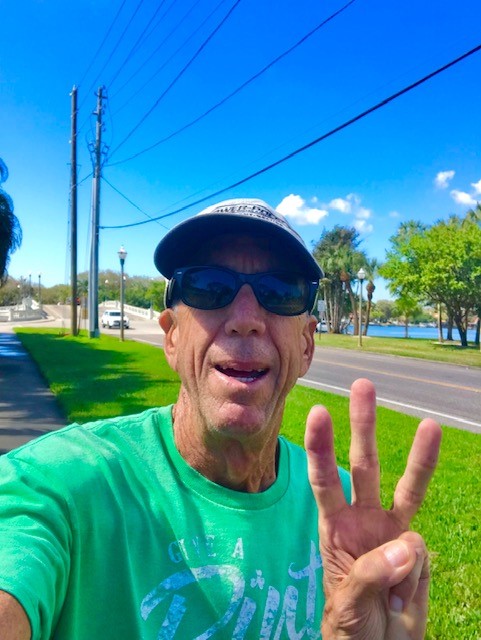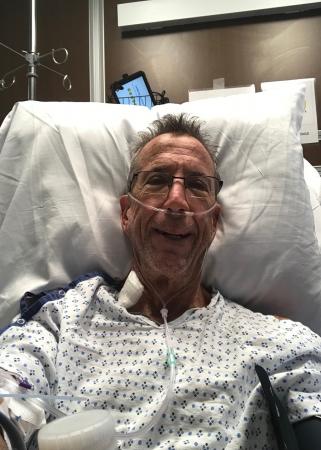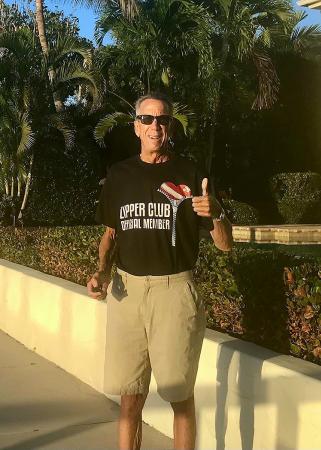Larry W.

The following is a first-person account by Larry W., 68, of his treatment at the Heart Valve Repair Center at The Mount Sinai Hospital, where he underwent surgery in January 2022, for repairs to his aortic and mitral valves.
Chapter 1 – Running from Bad Genes
It seems I was destined to meet Dr. David Adams from the day I was born. Unbeknownst to me or my parents were the congenital defects in my heart, the subtle ways the defects shaped my life, and how those defects were ultimately discovered. I come from bad genes vis-a-vis heart-related issues. My parents were heavy smokers and ate a lot of high-fat foods. My dad had his first heart attack in his 30s, had his aorta replaced at 50 due to an aneurysm, and died at 60 from heart failure. My mom had mitral valve prolapse, which ultimately led to heart failure at 74. Both of my parents had very high cholesterol. Two of my mom’s brothers died from aneurysms. Not a great gene stock.
I was 23 when my dad died, and the shock of his death started me on a path to a heart-healthy lifestyle. I took up distance running (before running shoes were invented) and changed my diet. I was literally trying to run from my genes, determined not to suffer the same fate as my dad. My cholesterol remained stubbornly high, and in my early 40s I began taking statins and remain on them to this day. The side effects are manageable and well worth it, given the alternative.
Upon moving to Florida at age 48 I had to find all new doctors. The two most important doctors you need in Florida are a dermatologist and a cardiologist, and you want your doctors to be younger than you. I found a great board-certified clinical cardiologist, Dr. Andrew Rosenthal. He was the first doctor to inform me that I had a heart murmur. An echo confirmed I had mitral valve prolapse (MVP), though my only symptoms were periodic pre-ventricular contractions. Dr. Rosenthal has been my rock for the last 20 years, and it was his deliberate but measured approach to monitoring my MVP that put me on a path to meet Dr. Adams.
Over the last 20 years my conversations with Dr. Rosenthal during my semiannual checkups gradually turned to addressing the MVP. I had noticed a gradual decrease in my physical performance but thought, at 68, it was because I was getting old. However, the regurgitation had become severe and the last two echoes showed mild enlargement of the left atrium.
Up until this point I could not reconcile the risk of open-heart surgery compared to the risk of doing nothing. On the other hand, I was relatively young and in good shape, which would help me recover faster post-surgery. The combination of the echo results and noticeable decrease in my physical performance convinced me it was time to take action.
Dr. Rosenthal agreed, and ordered a heart catheterization and trans-esophageal echocardiogram (TEE). The good news: the catheterization confirmed I had no coronary artery disease. The bad news: the TEE confirmed severe mitral regurgitation, a leaky tricuspid valve, a growth on my mildly leaky aortic valve, and a patent foramen ovale. I was stunned.
Chapter 2 – Finding a Surgeon
After 68 years, the intersection of my life and Dr. Adams was getting closer. I have lunch every week with a retired trial lawyer who made a living suing doctors. He is a few years older than me and had MVP, too. Like me, he had no outward symptoms but decided that waiting to get his valve fixed was too risky. He meticulously researched mitral valve repair hospitals and surgeons. He selected Dr. Adams and Mount Sinai for his surgery, and came through the procedure with flying colors. From that point on I had mitral valve envy. I also learned that the several other patients from Dr. Rosenthal’s cardiology practice group had their repairs done by Dr. Adams, all with great results. When I performed my own research, it became abundantly clear that Dr. Adams and his team were tops in the country, if not the world. More importantly, Dr. Adams specialized in doing valve repairs versus replacements. If a valve could be repaired, he was the one who could do it. Though I would have preferred to stay local, going to New York City in January was worth it given Dr. Adams’ reputation and unparalleled track record.
In October 2021, I contacted Dr. Adams’ office and had my test results sent to him. I had a Zoom call with Dr. Adams in November 2021, where he went over my results and what needed to be done. He said my issues were complicated, but that he was doing 14 surgeries that week on hearts similar to mine. Dr. Adams took his time with me, set my mind at ease, and was incredibly personable, humble and easy to talk to. He praised his team several times for helping to make him and his practice so successful.
Based on our conversation, I had no reservations about using Dr. Adams, and booked my surgery for January 28, 2022. Once the surgery was a certainty, I began an exercise routine focused on strengthening my arms and core. Doing so made a huge difference in my comfort and mobility while I was in the hospital. Trust me, moving around in a hospital bed after open heart surgery is difficult and painful. Being able to sit up using only my core muscles made my stay much more comfortable.
Chapter 3 – Undergoing Surgery
My wife and I flew to New York City and got a room at the Residence Inn in midtown. It was the perfect venue for a long-term stay. We both met Dr. Adams in person for the first time on January 26, 2022, when he went over the procedure and answered all our questions. We then had a lengthy and spirited discussion about the Patriots, Tom Brady and the Tampa Bay Buccaneers’ Super Bowl victory last year. Dr. Adams loves talking football.
My surgery on January 28, 2022, was successful, and though there were some minor post-surgery complications I was released from the hospital 9 days after surgery. Just one day after my release I rode 5.5 miles on a stationary bike, and the next day walked 1.5 miles on the treadmill with a 3% grade. Both workouts felt good, but definitely tired me out. I had my follow-up visit with Dr. Adams’ team on February 9, 2022. There, Dr. Maroun Yammine [The Mount Sinai Hospital’s Chief Resident for Integrated Cardiothoracic Surgery] confirmed the post-surgical murmur was gone, and I was given approval to fly home on February 11, 2022 – exactly two weeks after surgery!
I cannot say enough kind things about Dr. Adams, Dr. El-Eshmawi, and the team. I saw Dr. Adams or a doctor from his team every day I was in the hospital. The nursing staff in the cardiac wing were smart, kind and attentive. Even the food service people and janitors were all friendly and considerate. I hate staying in hospitals, but the staff at Mount Sinai made my stay as comfortable as possible. I am truly in awe of the work ethic of these healthcare workers, especially given the relentless pressures put upon them and their institution by the Covid pandemic.
Chapter 4 – Recovery
Two weeks after surgery, I am back in my own house and trying to wrap my head around what I went through. I find it hard to believe that two weeks ago I was on the operating table with my chest splayed open, my heart stopped, and hooked up to a heart-lung machine. Deft hands worked quickly to repair the defective valves and close the hole in my septum.
I consider what Dr. Adams and his team did for me a miracle. Dr. Adams literally holds someone’s heart and life in his hands, yet he remains incredibly humble and gives credit to his team. He is a role model as a surgeon, teacher and person. I am so fortunate that after 68 years our paths were destined to cross. I now have a new lease on life, and no longer have mitral valve envy.
I feel better every day, and the pain from the surgery is rapidly lessening. I do a lot of walking as I wait for my heart and chest to fully heal. I am looking forward to getting back on my bike and seeing just what my repaired heart can do. Knowing what I know now, I ask myself if I would do this again. The unequivocal answer is yes. I know I will eventually die from something, but it won’t be from heart failure related to mitral valve prolapse. I hope Dr. Adams and his team continue to perform miracles for all those who need one.

